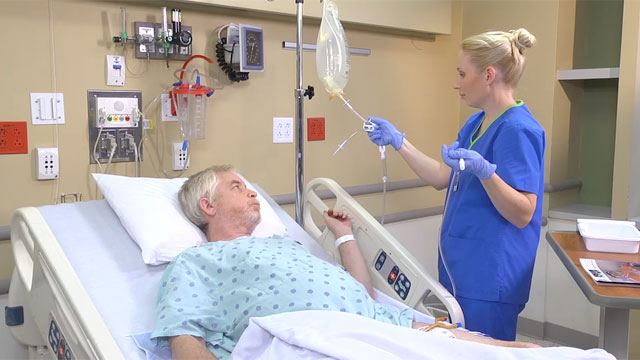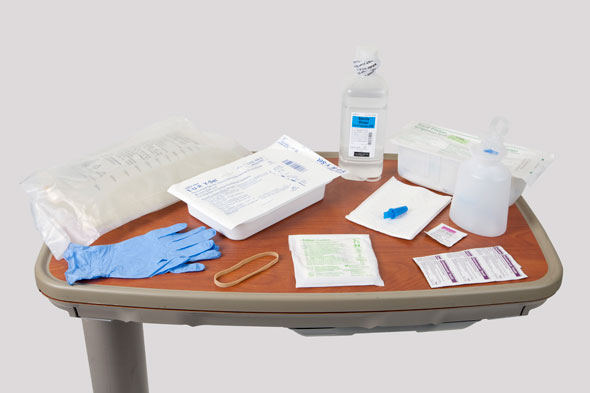Urinary Catheter Management
Select a Skill:
- » Inserting an Indwelling Urinary Catheter in a Female Patient
- » Inserting an Indwelling Urinary Catheter in a Male Patient
- » Irrigating a Urinary Catheter
- » Performing Intermittent Straight Catheterization
- » Obtaining a Specimen from an Indwelling Urinary Catheter
- » Removing an Indwelling Urinary Catheter
- » Caring for a Suprapubic Catheter
Take the Review Test:

Safety
- Avoid open catheter irrigation unless it is needed to relieve or prevent obstruction. The procedure requires breaking or opening the connection between the catheter and drainage bag of a closed urinary drainage system.
- Maintain strict asepsis during open catheter irrigation to minimize contamination and subsequent development of a urinary tract infection (UTI).
- If the patient’s bladder is distended, check to see if the flow of urine to the drainage bag has been blocked.
- When performing open irrigation, do not force the fluid through the tubing. The catheter may have become completely occluded; if so, it will need to be changed.
- If the drainage output is less than the amount of irrigation solution infused, or if the patient complains of pain during bladder irrigation, do the following:
- Examine the drainage tubing for clots, sediment, and kinks.
- Inspect the urine for the presence of or increase in blood clots and sediment.
- Evaluate the patient for pain and bladder distention.
- Notify the health care provider.
- If bright-red bleeding appears during continuous bladder irrigation (CBI) with the drip wide open, follow these steps:
- Assess for hypovolemic shock by measuring vital signs, checking skin color and moisture, and noting the patient’s anxiety level.
- Leave the irrigation drip wide open, and notify the health care provider.
- If the patient has a fever; cloudy, foul-smelling urine; abdominal pain; or change in mental status, indicating a possible infection, do the following:
- Notify the health care provider.
- Monitor the patient’s vital signs and the character of his or her urine.
- Empty the drainage bag frequently (every 1 to 2 hours) during bladder irrigation. The bag will fill rapidly, and the irrigant will be unable to flow freely if it is not emptied. As a result, the bladder may become overdistended, causing discomfort and possible injury.
Equipment
(Roll cursor over items to see labels)

Sterile solution for closed continuous irrigation
Irrigation tubing for closed continuous irrigation
Sterile solution for intermittent irrigation
Antiseptic wipes
Clean gloves
Rubber band (for closed intermittent method only)
Disposable sterile irrigation kit
- Waterproof drape (may be part of a kit)
- Collection basin (may be part of a kit)
30 to 60 mL piston-type irrigation syringe
Sterile solution container
Sterile catheter plug (for open intermittent irrigation)
Sterile gloves (for open intermittent irrigation)
Delegation
The skill of catheter irrigation may not be delegated to nursing assistive personnel (NAP). Be sure to inform NAP of the following:
- Instruct NAP to report if the patient complains of pain, discomfort, or leakage around the catheter.
- Direct NAP to monitor and record I&O, and to report immediately any decrease in urine output.
- Instruct NAP to report any change in the color of the urine, especially the appearance of blood clots.
Preparation
- Verify the following in the medical record:
- The order specifying the irrigation method to be used, such as continuous or intermittent; the type of solution, such as sterile saline or medicated solution; and the amount of irrigant needed
- The type of catheter that is in place
- Palpate the patient’s bladder for distention and tenderness.
- Assess the patient for abdominal pain or spasms, sensation of bladder fullness, and leakage of urine around the catheter.
- Observe the color, amount, and clarity of the urine, and check for mucus, blood clots, and sediment.
- Monitor I&O. If continuous bladder irrigation (CBI) is being performed, the amount of bladder drainage should exceed the amount of fluid instilled.
- Assess the patient’s knowledge of the purpose of catheter irrigation.
Follow-up
- Measure actual urine output by subtracting the total amount of irrigation fluid infused from the total volume drained.
- Review the I&O flowsheet to verify that the hourly output into the drainage bag is in appropriate proportion to the amount of irrigating solution entering the bladder. Expect more output than the amount of fluid instilled, because the output is increased by the patient’s urine production.
- Inspect the urine for blood clots and sediment, and be sure the tubing is not kinked or otherwise occluded.
- Assess the patient for comfort.
- Assess the patient for signs and symptoms of urinary tract infection.
Documentation
- Record the irrigation method used, the amount of and type of irrigation solution used, amount of drainage, characteristics of the output, total urine output total, and the patient’s tolerance of the procedure.
- Report to the health care provider any catheter occlusion, sudden bleeding, infection, or increased pain.
- Record I&O on the appropriate flowsheet.
Review Questions
1. During intermittent open bladder irrigation, a patient complains of pain. Which action would the nurse take first?
 Examine the drainage tubing for clots, sediment, and kinks.
Examine the drainage tubing for clots, sediment, and kinks. Notify the health care provider.
Notify the health care provider. Leave the irrigation drip wide open.
Leave the irrigation drip wide open. Monitor the patient’s vital signs.
Monitor the patient’s vital signs.
2. Which action would the nurse take to minimize a patient’s risk for injury during urinary catheter irrigation?
 Change the tubing every 8 hours.
Change the tubing every 8 hours.  Use slow, even pressure when injecting the irrigating fluid.
Use slow, even pressure when injecting the irrigating fluid. Adhere to aseptic technique during the irrigation process.
Adhere to aseptic technique during the irrigation process. Monitor the patient’s temperature every 4 hours.
Monitor the patient’s temperature every 4 hours.
3. Which instruction might the nurse give to nursing assistive personnel (NAP) helping to care for a patient receiving bladder irrigation?
 “Tell me how he tolerates the irrigation.”
“Tell me how he tolerates the irrigation.” “Be sure to check for signs of a urinary tract infection.”
“Be sure to check for signs of a urinary tract infection.” “Measure and report the patient’s temperature to me every 4 hours.”
“Measure and report the patient’s temperature to me every 4 hours.” “Ask the patient about pain level.”
“Ask the patient about pain level.”
4. Which action is most important in reducing the risk for infection in a patient receiving open intermittent irrigation of a urinary catheter?
 Attaching the urinary drainage bag to the bed frame
Attaching the urinary drainage bag to the bed frame Inspecting the drainage tubing for kinks
Inspecting the drainage tubing for kinks Disposing of contaminated items after the procedure
Disposing of contaminated items after the procedure Cleaning the end of the drainage tubing with an antiseptic wipe before reconnecting it to the catheter
Cleaning the end of the drainage tubing with an antiseptic wipe before reconnecting it to the catheter
5. Which action would the nurse take to manage continuous urinary catheter irrigation for a patient whose urine is bright red and contains clots?
 Increase the irrigation drip rate.
Increase the irrigation drip rate. Notify the patient’s health care provider of the blood and clots in the urine.
Notify the patient’s health care provider of the blood and clots in the urine. Encourage the patient to increase fluid intake.
Encourage the patient to increase fluid intake. Apply ice to the patient’s lower abdominal area.
Apply ice to the patient’s lower abdominal area.
You have completed the Review Questions for this skill. To take the Review again select the Start Over button. To proceed to another skill select from the dropdown menu. Select the Home or Back button to proceed to the next section.

